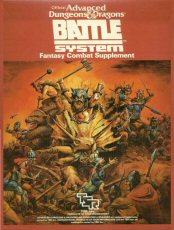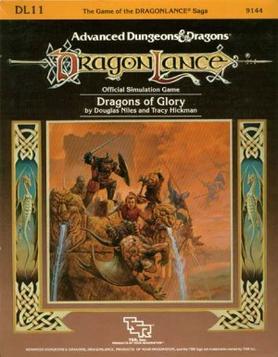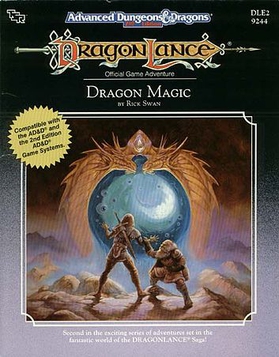Dragonlance is a fantasy board game published by TSR in 1988 that is based upon the fantasy role-playing campaign setting Dragonlance , also published by TSR.
Contents

Dragonlance is a fantasy board game published by TSR in 1988 that is based upon the fantasy role-playing campaign setting Dragonlance , also published by TSR.

Dragonlance is a game for 2-6 players, in which each player uses their team of dragons to enter a forbidden tower and be the first to get the Dragonlance and return it to their home base. [1]
The board comes with a mounted hex grid map board. In the center is a plastic tower surrounded by six gates, each a different color. There are six dragon teams in six colors, as well as a large quantity of white plastic bases, used to indicate a dragon's altitude. [2] There are also a deck of cards and several ten-sided dice. [1]
The active player rolls a ten-sided die for movement points, which can then be used to move forward, as well as to gain or lose altitude. [2] As a dragon rises in altitude, a white plastic disk is placed under it for every movement point used to climb. These disks are removed as a dragon loses altitude. If a player rolls only a 1 or 2 for movement points, the player gains a magic card in compensation, which can be used when needed. [1]
If a dragon ends its movement beside another dragon and at the same altitude, it can attack. Both players roll a die; the attacker adds +1 to their die roll for each movement point used that turn. The highest total wins, and the losing dragon is forced to reduce altitude, losing one white disk for each point of difference in the die rolls. [2] If a dragon reaches the ground (loses all its white disks), it is out of the game. [1]
Each player must fly one of their dragons through their gate (the gate that matches the color of their team), then gain altitude to fly to the top of the central tower (requiring ten altitude disks), where the dragon can grasp the Dragonlance. If the dragon is able to return the Dragonlance to its home base, the owning player wins the game. [1]
The advanced games adds rules for leaders, who can give the dragon they are riding unique abilities; flying citadels which can hide powerful artifacts; aerial stunts; and optional rules for advanced movement and combat. [1]
In the first ten years of Dungeons & Dragons , the de facto campaign universe was Gary Gygax's World of Greyhawk . In 1984, TSR published its second campaign setting, Dragonlance, created by Laura and Tracy Hickman, which proved to be very popular. In addition to a series of D&D modules, Tracy Hickman and Margaret Weis also created a series of novels. Other licensed products soon followed, including the Dragonlance board game. The game was designed by Michael Dobson, Scott Haring, and Warren Spector, and was released in 1988.
In 2022, Wizards of the Coast, who had taken over TSR 25 years before, released a new board game, Dragonlance: Warriors of Krynn, [3] which was completely unrelated to the original board game.
In Issue #2 of Games International , Richard Ashley was pleased by the low price, but not by much else. He had trouble constructing the central tower and the six gates, noting the pieces didn't fit properly. He also found that "two of the six dragon teams (bronze and gold) were virtually impossible to tell apart. I eventually marked one with a felt tip". In the Basic game, Ashley felt that it was all based on die rolls, saying that "in practice, the opening moves tend to be a bloodbath on the crowded board with those throwing high decimating those who throw low, giving little chance to catch up". He didn't find much improvement in the advanced rules, finding, for instance, that "the aerial stunts are a feeble attempt to give the illusion of 'dog-fights' but are dependent on throwing in powerful magic cards". He also found that high die rolls were necessary to win in the Advanced game. Ashley concluded by giving the game a poor rating of only 2 stars out of 5: "All in all, the game didn't live up to its potential. I feel the makers lost their way a bit and haven't produced a good fantasy or aerial combat game. [...] Only the relatively low price stopped me giving it one star". [1]
Rick Swan pointed out that Dragonlance is simply a wargame "substituting magic wands and dragons for machine guns and Marines", but Swan didn't think the wargame-as-fantasy worked, saying "TSR's Dragonlance board game boiled down to a tactical air game, using flying dragons instead of Messerschmitts. Though well-designed war games of any type can be fun, fantasy board games invariably lack the sophisticated mechanics and historical resonance of military simulations, which makes me lose interest fast". [4]
In a retrospective review, Matt Sall tried the game 34 years after its publication and was pleasantly surprised that he enjoyed it, concluding: "The Dragonlance board game is so much better than I expected! Most Dungeons & Dragons based board games are your typical dungeon crawlers. Not that there's anything wrong with that, but this is such a departure from that. [...] if you're into games like X-Wing and looking for something with a little different flavor, see if you can dig up a copy of Dragonlance". [2]

TSR, Inc. was an American game publishing company, best known as the original publisher of Dungeons & Dragons (D&D). Its earliest incarnation, Tactical Studies Rules, was founded in October 1973 by Gary Gygax and Don Kaye. Gygax had been unable to find a publisher for D&D, a new type of game he and Dave Arneson were co-developing, so he founded the new company with Kaye to self-publish their products. Needing financing to bring their new game to market, Gygax and Kaye brought in Brian Blume in December as an equal partner. Dungeons & Dragons is generally considered the first tabletop role-playing game (TTRPG), and established the genre. When Kaye died suddenly in 1975, the Tactical Studies Rules partnership restructured into TSR Hobbies, Inc. and accepted investment from Blume's father Melvin. With the popular D&D as its main product, TSR Hobbies became a major force in the games industry by the late 1970s. Melvin Blume eventually transferred his shares to his other son Kevin, making the two Blume brothers the largest shareholders in TSR Hobbies.
Dragonlance is a shared universe created by Laura and Tracy Hickman, and expanded by Tracy Hickman and Margaret Weis under the direction of TSR, Inc. into a series of fantasy novels. The Hickmans conceived Dragonlance while driving in their car on the way to TSR for a job interview. Tracy Hickman met his future writing partner Margaret Weis at TSR, and they gathered a group of associates to play the Dungeons & Dragons role-playing game. The adventures during that game inspired a series of gaming modules, a series of novels, licensed products such as board games, and lead miniature figures.

Dragon Strike is a 1993 adventure board game from TSR, Inc. based on the Dungeons & Dragons (D&D) fantasy role-playing game. It was intended to be a pathway for beginners to start with, and for players to eventually play the full Advanced Dungeons & Dragons tabletop game after kindling their interest.
An owlbear is a fictional creature originally created for the Dungeons & Dragons fantasy role-playing game. An owlbear is depicted as a cross between a bear and an owl, which "hugs" like a bear and attacks with its beak. Inspired by a plastic toy made in Hong Kong, Gary Gygax created the owlbear and introduced the creature to the game in the 1975 Greyhawk supplement; the creature has since appeared in every subsequent edition of the game. Owlbears, or similar beasts, also appear in several other fantasy role-playing games, video games and other media.

Empire of the Petal Throne is a fantasy role-playing game designed by M. A. R. Barker, based on his Tékumel fictional universe. It was self-published in 1974, then published by TSR, Inc. in 1975. It was one of the first tabletop role-playing games, along with Dungeons & Dragons, and was the first published RPG game setting. Over the subsequent thirty years, several new games were published based on the Tékumel setting, but to date none have met with commercial success. While published as fantasy, the game is sometimes classified as science fantasy or, debatably, as science fiction.

Larry Elmore is an American fantasy artist whose work includes creating illustrations for video games, comics, magazines, and fantasy books. His list of work includes illustrations for Dungeons & Dragons, Dragonlance, and his own comic strip series SnarfQuest. He is author of the book Reflections of Myth.

Battlesystem is a tabletop miniature wargame designed as a supplement for use with the Dungeons & Dragons role-playing game. The original Battlesystem was printed as a boxed set in 1985 for use with the first edition AD&D rules. For the second edition of AD&D, a new version of Battesystem was printed as a softcover book in 1989.

Dungeon! is an adventure board game designed by David R. Megarry and first released by TSR, Inc. in 1975. Additional contributions through multiple editions were made by Gary Gygax, Steve Winter, Jeff Grubb, Chris Dupuis and Michael Gray. Dungeon! simulates some aspects of the Dungeons & Dragons (D&D) role-playing game, which was released in 1974, although Megarry had a prototype of Dungeon! ready as early as 1972.
The Dungeons & Dragons (D&D) fantasy role-playing game has been adapted into many related products, including magazines, films and video games.
The DL series is a series of adventures and some supplementary material for the Advanced Dungeons & Dragons role playing game. These modules along with the Dragonlance Chronicles trilogy of novels, which follow one possible adventure series through the modules, were the first published items that established the Dragonlance fictional universe. The original DL series was released from 1984 to 1986, with the final two modules added to it in 1988. In the 1990s these roleplaying adventures from the original series were collected and revised for 2nd Edition AD&D as the three DLC Dragonlance Classics modules. There were also versions of the module series released in 1999, 2000 and 2006.

Dragons of Despair is the first in a series of 16 Dragonlance adventures published by TSR, Inc. (TSR) between 1984 and 1988. It is the start of the first major story arc in the Dragonlance series of Dungeons & Dragons (D&D) role-playing game modules, a series of ready-to-play adventures for use by Dungeon Masters in the game. This series provides a game version of the original Dragonlance storyline later told in the Dragonlance Chronicles trilogy of novels. This module corresponds to the events told in the first half of the novel Dragons of Autumn Twilight by Margaret Weis and Tracy Hickman. Its module code is DL1, which is used to designate it as the first part of the Dragonlance adventure series.

Dragons of Glory is a Dungeons & Dragons source book in a series of modules from the Dragonlance campaign setting. It is one of the 16 DL modules published by TSR between 1984 and 1986.
In the Dungeons & Dragons fantasy role-playing game, a magic item is any object that is imbued with magic powers. These items may act on their own or be the tools of the character possessing them. Magic items have been prevalent in the game in every edition and setting, from the original edition in 1974 until the modern fifth edition. In addition to jewels and gold coins, they form part of the treasure that the players often seek in a dungeon. Magic items are generally found in treasure hoards, or recovered from fallen opponents; sometimes, a powerful or important magic item is the object of a quest.

Dragon Magic is an adventure module published by TSR in 1989 for the Dungeons & Dragons fantasy role-playing game, specifically the Dragonlance campaign setting.

Dragonlance Classics is a series of adventure modules for the Advanced Dungeons & Dragons fantasy role-playing game.

Player's Guide to the Dragonlance Campaign is an accessory for the 2nd edition of the Advanced Dungeons & Dragons fantasy role-playing game, published in 1993.
The Dragonlance Chronicles is a trilogy of fantasy novels written by Margaret Weis and Tracy Hickman, which take place in the Dragonlance setting. This series is the first set of Dragonlance novels, and is followed by the Dragonlance Legends series.
Rick Swan is a game designer and author who worked for TSR. His work for TSR, mostly for Advanced Dungeons & Dragons, appeared from 1989 to 1995.
Role Aids is a line of role-playing game supplements published by Mayfair Games starting in 1982 intended for use with Advanced Dungeons & Dragons.